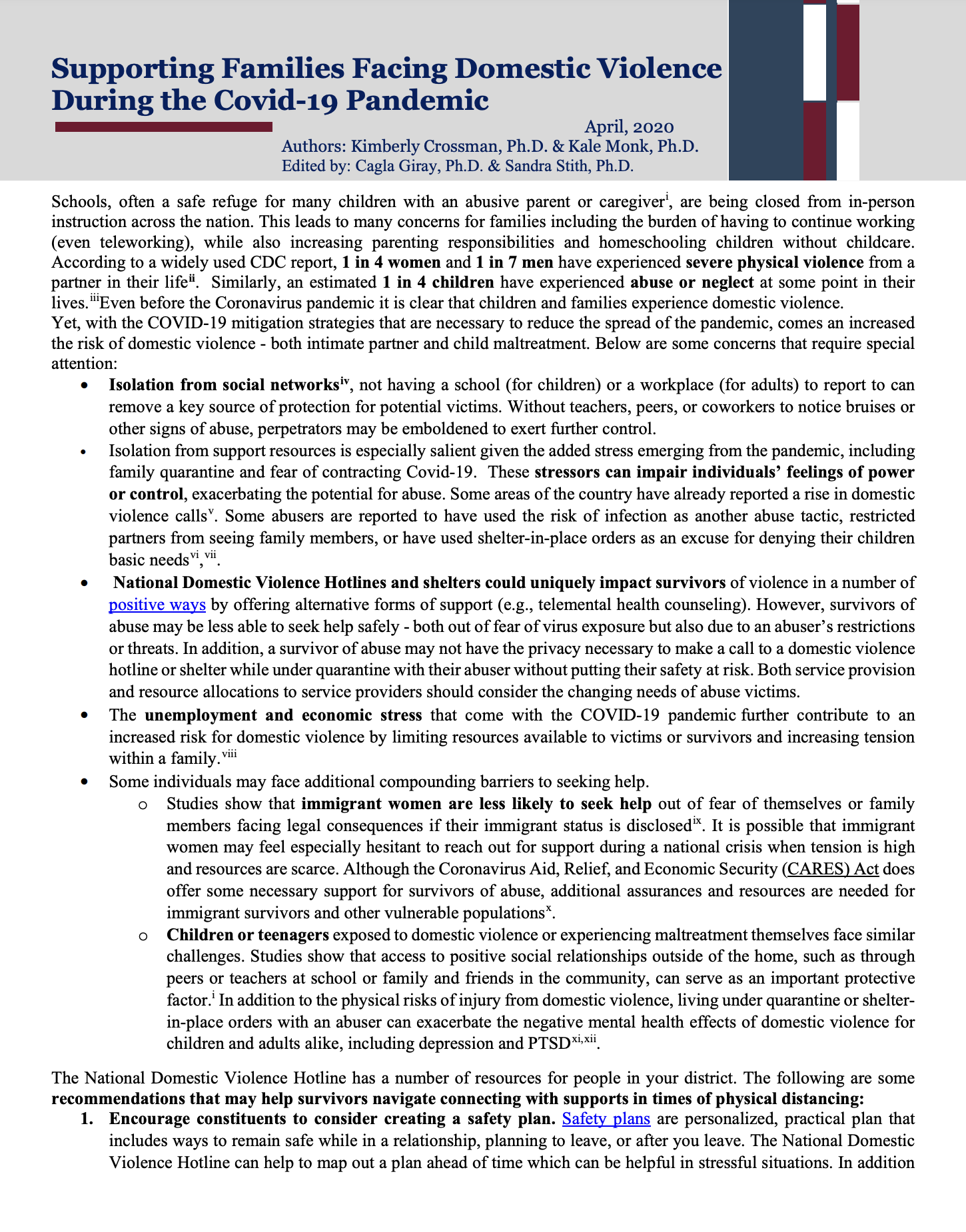
Schools, often a safe refuge for many children with an abusive parent or caregiver [i], are being closed from in-person instruction across the nation. This leads to many concerns for families including the burden of having to continue working (even teleworking), while also increasing parenting responsibilities and homeschooling children without childcare. According to a widely used CDC report, 1 in 4 women and 1 in 7 men have experienced severe physical violence from a partner in their life [ii]. Similarly, an estimated 1 in 4 children have experienced abuse or neglect at some point in their lives [iii]. Even before the Coronavirus pandemic it is clear that children and families experience domestic violence. Yet, with the COVID-19 mitigation strategies that are necessary to reduce the spread of the pandemic, comes an increased the risk of domestic violence – both intimate partner and child maltreatment. Below are some concerns that require special attention:
- Isolation from social networks [iv], not having a school (for children) or a workplace (for adults) to report to can remove a key source of protection for potential victims. Without teachers, peers, or coworkers to notice bruises or other signs of abuse, perpetrators may be emboldened to exert further control.
- Isolation from support resources is especially salient given the added stress emerging from the pandemic, including family quarantine and fear of contracting Covid-19. These stressors can impair individuals’ feelings of power or control, exacerbating the potential for abuse. Some areas of the country have already reported a rise in domestic violence callsv. Some abusers are reported to have used the risk of infection as another abuse tactic, restricted partners from seeing family members, or have used shelter-in-place orders as an excuse for denying their children basic needs [vi],[vii].
- National Domestic Violence Hotlines and shelters could uniquely impact survivors of violence in a number of positive ways by offering alternative forms of support (e.g., telemental health counseling). However, survivors of abuse may be less able to seek help safely – both out of fear of virus exposure but also due to an abuser’s restrictions or threats. In addition, a survivor of abuse may not have the privacy necessary to make a call to a domestic violence hotline or shelter while under quarantine with their abuser without putting their safety at risk. Both service provision and resource allocations to service providers should consider the changing needs of abuse victims.
- The unemployment and economic stress that come with the COVID-19 pandemic further contribute to an increased risk for domestic violence by limiting resources available to victims or survivors and increasing tension within a family [viii].
- Some individuals may face additional compounding barriers to seeking help.
- Studies show that immigrant women are less likely to seek help out of fear of themselves or family members facing legal consequences if their immigrant status is disclosed [ix]. It is possible that immigrant women may feel especially hesitant to reach out for support during a national crisis when tension is high and resources are scarce. Although the Coronavirus Aid, Relief, and Economic Security (CARES) Act does offer some necessary support for survivors of abuse, additional assurances and resources are needed for immigrant survivors and other vulnerable populations [x].
- Children or teenagers exposed to domestic violence or experiencing maltreatment themselves face similar challenges. Studies show that access to positive social relationships outside of the home, such as through peers or teachers at school or family and friends in the community, can serve as an important protective factor.i In addition to the physical risks of injury from domestic violence, living under quarantine or shelter- in-place orders with an abuser can exacerbate the negative mental health effects of domestic violence for children and adults alike, including depression and PTSD [xi],[xii].
The National Domestic Violence Hotline has a number of resources for people in your district. The following are some recommendations that may help survivors navigate connecting with supports in times of physical distancing:
- Encourage constituents to consider creating a safety plan. Safety plans are personalized, practical plan that includes ways to remain safe while in a relationship, planning to leave, or after you leave. The National Domestic Violence Hotline can help to map out a plan ahead of time which can be helpful in stressful situations. In addition to contacting the Hotline for assistance developing a safety plan, especially during a National Emergency when shelters might have limited availability, individuals can use this resource through Love is Respect.
- Normalize self-care for the individuals in your districts. It is always important for people to make time for their health and well-being, but it is especially timely during the COVID-19 pandemic, which is rife with stress and uncertainty. It is important to note that typical self-care suggestions for your constituency may need to be adapted for safety in the context of potential physical violence (e.g., walking alone in a park) and social support may seem limited while individuals practice physical distancing (e.g., they may be physically separated from supportive friends). When it is safe to do so (e.g., when a perpetrator will not overhear), connecting with family and friends virtually (via FaceTime, Marco Polo, Snap Chat, Skype, etc.) may be helpful for them.
- Make help resources available and accessible for the constituents. Physical distancing can feel isolating, which makes maintaining social connections online or over the phone, if it is safe to do so, vital. For any victims and survivors who need support, the 24/7 Hotline [xiii] is here for them,. In addition to serving as a social support, domestic violence hotlines help educate survivors about safety planning, raise awareness about the abuse taking place, and connecting callers with other resources [xiv].
End Notes / References
[i] Benavides, L. E. (2015). Protective factors in children and adolescents exposed to intimate partner violence: An empirical research review. Child and Adolescent Social Work Journal, 32, 93-107
[ii] https://www.cdc.gov/violenceprevention/pdf/nisvs_report2010-a.pdf
[iii] https://www.cdc.gov/injury/features/prevent-child-abuse/index.html
{iv] https://www.cdc.gov/violenceprevention/intimatepartnerviolence/riskprotectivefactors.html
[vi] https://www.nytimes.com/2020/03/23/opinion/covid-domestic-violence.html
[viii] https://www.cdc.gov/violenceprevention/intimatepartnerviolence/riskprotectivefactors.html
[ix] Zadnik, E., Sabina, C., & Cuevas, C. A. (2016). Violence against Latinas the effects of undocumented status on rates of victimization and help-seeking. Journal of Interpersonal Violence, 31, 1141–1153.
[xi] Adult consequences: https://www.cdc.gov/violenceprevention/intimatepartnerviolence/fastfact.html
[xii] Child consequences: https://www.cdc.gov/violenceprevention/childabuseandneglect/fastfact.html
[xiii] “Call 1-800-799-7233 or 1-800-799-7233 for TTY, or if they’re unable to speak safely, they can log onto thehotline.org or text LOVEIS to 22522.”
[xiv] https://www.acf.hhs.gov/sites/default/files/opre/advhocat_snapshot_4_immediate_outcomes_b508.pdf
The Research-to-Policy Collaboration (RPC) works to bring together research professionals and public officials to support evidence-based policy. Please visit their website to learn more.
Key Information
RPC Website
Research-to-Policy Collaboration
More RPC Resources
RPC Resources
Publication DateApril 1, 2020
Topic Area(s)Social Services, Health
Resource TypeWritten Briefs
Share This Page
Schools, often a safe refuge for many children with an abusive parent or caregiver [i], are being closed from in-person instruction across the nation. This leads to many concerns for families including the burden of having to continue working (even teleworking), while also increasing parenting responsibilities and homeschooling children without childcare. According to a widely used CDC report, 1 in 4 women and 1 in 7 men have experienced severe physical violence from a partner in their life [ii]. Similarly, an estimated 1 in 4 children have experienced abuse or neglect at some point in their lives [iii]. Even before the Coronavirus pandemic it is clear that children and families experience domestic violence. Yet, with the COVID-19 mitigation strategies that are necessary to reduce the spread of the pandemic, comes an increased the risk of domestic violence – both intimate partner and child maltreatment. Below are some concerns that require special attention:
- Isolation from social networks [iv], not having a school (for children) or a workplace (for adults) to report to can remove a key source of protection for potential victims. Without teachers, peers, or coworkers to notice bruises or other signs of abuse, perpetrators may be emboldened to exert further control.
- Isolation from support resources is especially salient given the added stress emerging from the pandemic, including family quarantine and fear of contracting Covid-19. These stressors can impair individuals’ feelings of power or control, exacerbating the potential for abuse. Some areas of the country have already reported a rise in domestic violence callsv. Some abusers are reported to have used the risk of infection as another abuse tactic, restricted partners from seeing family members, or have used shelter-in-place orders as an excuse for denying their children basic needs [vi],[vii].
- National Domestic Violence Hotlines and shelters could uniquely impact survivors of violence in a number of positive ways by offering alternative forms of support (e.g., telemental health counseling). However, survivors of abuse may be less able to seek help safely – both out of fear of virus exposure but also due to an abuser’s restrictions or threats. In addition, a survivor of abuse may not have the privacy necessary to make a call to a domestic violence hotline or shelter while under quarantine with their abuser without putting their safety at risk. Both service provision and resource allocations to service providers should consider the changing needs of abuse victims.
- The unemployment and economic stress that come with the COVID-19 pandemic further contribute to an increased risk for domestic violence by limiting resources available to victims or survivors and increasing tension within a family [viii].
- Some individuals may face additional compounding barriers to seeking help.
- Studies show that immigrant women are less likely to seek help out of fear of themselves or family members facing legal consequences if their immigrant status is disclosed [ix]. It is possible that immigrant women may feel especially hesitant to reach out for support during a national crisis when tension is high and resources are scarce. Although the Coronavirus Aid, Relief, and Economic Security (CARES) Act does offer some necessary support for survivors of abuse, additional assurances and resources are needed for immigrant survivors and other vulnerable populations [x].
- Children or teenagers exposed to domestic violence or experiencing maltreatment themselves face similar challenges. Studies show that access to positive social relationships outside of the home, such as through peers or teachers at school or family and friends in the community, can serve as an important protective factor.i In addition to the physical risks of injury from domestic violence, living under quarantine or shelter- in-place orders with an abuser can exacerbate the negative mental health effects of domestic violence for children and adults alike, including depression and PTSD [xi],[xii].
The National Domestic Violence Hotline has a number of resources for people in your district. The following are some recommendations that may help survivors navigate connecting with supports in times of physical distancing:
- Encourage constituents to consider creating a safety plan. Safety plans are personalized, practical plan that includes ways to remain safe while in a relationship, planning to leave, or after you leave. The National Domestic Violence Hotline can help to map out a plan ahead of time which can be helpful in stressful situations. In addition to contacting the Hotline for assistance developing a safety plan, especially during a National Emergency when shelters might have limited availability, individuals can use this resource through Love is Respect.
- Normalize self-care for the individuals in your districts. It is always important for people to make time for their health and well-being, but it is especially timely during the COVID-19 pandemic, which is rife with stress and uncertainty. It is important to note that typical self-care suggestions for your constituency may need to be adapted for safety in the context of potential physical violence (e.g., walking alone in a park) and social support may seem limited while individuals practice physical distancing (e.g., they may be physically separated from supportive friends). When it is safe to do so (e.g., when a perpetrator will not overhear), connecting with family and friends virtually (via FaceTime, Marco Polo, Snap Chat, Skype, etc.) may be helpful for them.
- Make help resources available and accessible for the constituents. Physical distancing can feel isolating, which makes maintaining social connections online or over the phone, if it is safe to do so, vital. For any victims and survivors who need support, the 24/7 Hotline [xiii] is here for them,. In addition to serving as a social support, domestic violence hotlines help educate survivors about safety planning, raise awareness about the abuse taking place, and connecting callers with other resources [xiv].
End Notes / References
[i] Benavides, L. E. (2015). Protective factors in children and adolescents exposed to intimate partner violence: An empirical research review. Child and Adolescent Social Work Journal, 32, 93-107
[ii] https://www.cdc.gov/violenceprevention/pdf/nisvs_report2010-a.pdf
[iii] https://www.cdc.gov/injury/features/prevent-child-abuse/index.html
{iv] https://www.cdc.gov/violenceprevention/intimatepartnerviolence/riskprotectivefactors.html
[vi] https://www.nytimes.com/2020/03/23/opinion/covid-domestic-violence.html
[viii] https://www.cdc.gov/violenceprevention/intimatepartnerviolence/riskprotectivefactors.html
[ix] Zadnik, E., Sabina, C., & Cuevas, C. A. (2016). Violence against Latinas the effects of undocumented status on rates of victimization and help-seeking. Journal of Interpersonal Violence, 31, 1141–1153.
[xi] Adult consequences: https://www.cdc.gov/violenceprevention/intimatepartnerviolence/fastfact.html
[xii] Child consequences: https://www.cdc.gov/violenceprevention/childabuseandneglect/fastfact.html
[xiii] “Call 1-800-799-7233 or 1-800-799-7233 for TTY, or if they’re unable to speak safely, they can log onto thehotline.org or text LOVEIS to 22522.”
[xiv] https://www.acf.hhs.gov/sites/default/files/opre/advhocat_snapshot_4_immediate_outcomes_b508.pdf
The Research-to-Policy Collaboration (RPC) works to bring together research professionals and public officials to support evidence-based policy. Please visit their website to learn more.

Key Information
RPC Website
Research-to-Policy Collaboration
More RPC Resources
RPC Resources
Publication DateApril 1, 2020
Topic Area(s)Social Services, Health
Resource TypeWritten Briefs
Share This Page
LET’S STAY IN TOUCH
Join the Evidence-to-Impact Mailing List
Keep up to date with the latest resources, events, and news from the EIC.




